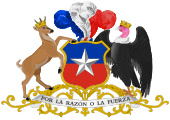| |||||||||||||||||||||||||||||||||||||||||||||||||||||||
All 150 seats in the Chamber of Deputies | |||||||||||||||||||||||||||||||||||||||||||||||||||||||
This lists parties that won seats. See the complete results below. | |||||||||||||||||||||||||||||||||||||||||||||||||||||||
25 of the 50 seats in the Senate | |||||||||||||||||||||||||||||||||||||||||||||||||||||||
This lists parties that won seats. See the complete results below. | |||||||||||||||||||||||||||||||||||||||||||||||||||||||
 |
|---|
|
|
Parliamentary elections were held in Chile on 4 March 1973,[1] They resulted in a victory for the Confederation of Democracy, an opposition alliance led by the National Party and the Christian Democratic Party. However, they were unable to secure the necessary two-thirds majority in the Senate to remove President Salvador Allende from office.
The approval of Law No. 17,284 in 1970 led to a rise in voter participation. These elections marked the implementation of the reform on a nationwide scale, resulting in the highest level of voter engagement within the previous democratic system. Around 80.6% of the electorate (equivalent to 44% of the national population) were registered to vote, and 81% of the registered voters (approximately 3.7 million individuals) exercised their right to vote.[2]
- ^ Dieter Nohlen (2005) Elections in the Americas: A data handbook, Volume II, p262 ISBN 978-0-19-928358-3
- ^ "Electores, sufragio y democracia en Chile: una mirada histórica" (PDF). 2000.